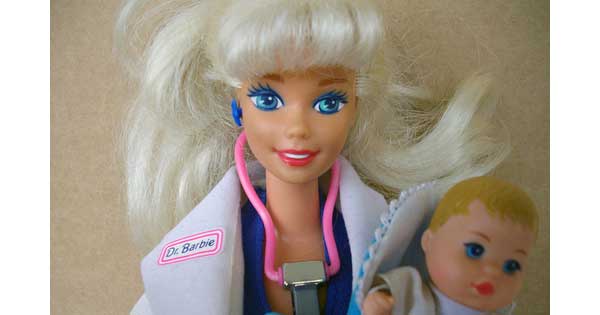
American women are vastly underrepresented in science, technology, engineering, and math (STEM), holding less than 25 percent of STEM positions despite being employed in nearly 50 percent of all jobs in the country, according to a U.S. Department of Commerce report. A number of factors that could explain the discrepancy, the 2011 report concludes, include “a lack of female role models, gender stereotyping, and less family-friendly flexibility” in the STEM fields.
Could such gender stereotyping begin in early childhood? One recent small study suggests that the type of toys that girls are given to play with—Barbie vs. Mrs. Potato Head in the study—might possibly influence their career choices as early as age four.
Psychologists Aurora Sherman of Oregon State University and Eileen Zurbriggen of the University of California, Santa Cruz enrolled 37 girls aged four to seven years in their study on “Effect of Barbie Play on Girls’ Career Cognitions.” Each girl was randomly assigned to play with either one of two types of Barbie doll—Dr. Barbie or Fashion Barbie—or Mrs. Potato Head.
As the authors note, although Baby Doctor Barbie wears a short white lab coat and is equipped with both a stethoscope and an otoscope (for ear examination), her “unattainable” figure is outfitted in a skintight top and body-hugging jeans embedded with pink glitter. Fashion Barbie wears a formfitting, V-neck, short-sleeved, pink-and-black-lace gown with pink high heels and carries a purse and a hairbrush. (Fact: Barbie’s plastic feet are pre-molded for high heels.) Mrs. Potato Head, though “a feminine doll with a well-known female persona,” lacks such sexualized traits.
After five minutes of play, the girls in each group were shown pictures depicting 11 professions—five of them, according to Bureau of Labor statistics, “male-dominated” (construction worker, firefighter, pilot, doctor and police officer), five “female-dominated” (teacher, librarian, daycare worker, flight attendant and nurse) and one neutral (restaurant server). The girls were asked two questions: “Could you do this job when you grow up?” and “Could a boy do this job when he grows up?” The girls who played with either Barbie doll envisioned themselves in fewer professions than are possible for boys, while those who played with Mrs. Potato Head saw themselves in almost as many occupations as boys.
As the authors note, the manufacturer’s marketers stress the “aspirational” nature of Barbie, with her supposed ability to “be anything you want to be.” But her sexualized persona sends a message “that it is imperative for girls to be attractive and sexy, even at very young ages, and to focus on appearance even to the exclusion of developing other dimensions such as competence, agency [the ability to behave independently and make choices], or self-confidence.”
Naturally, I am in favor of encouraging an interest in science—as well as self-confidence and competence—in both my daughter as well as my son. So I asked Aurora Sherman if I should ban Barbie from our home. “I am uncomfortable telling individual parents what they should do for their children,” she emailed back. Nevertheless, she says, “Kids learn about the world from birth based on several things: what we show to and say about them, and what we do and say about ourselves.”
So in addition to encouraging “active play for both girls and boys, talking with girls and boys about what they are thinking, what they are interested in, and what they want to build, make, crash down, get messy with,” Sherman says, we should also model the values we wish to impart. “Are you brave about trying new challenging activities or active play with them?” she asks. “Do you play Legos or blocks or try simple science experiments with them, or is that the domain of a dad or male relative or friend? Do your kids see you valuing nurturance for your daughter but not for your son?
“Our own behavior as parents is just as, if not more, important that the opportunities we provide for kids to engage in.”


